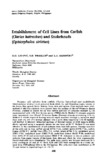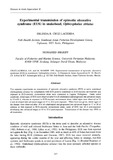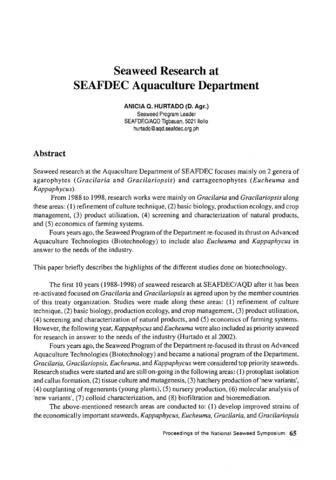Establishment of cell lines from catfish (Clarias batrachus) and snakeheads (Ophicephalus striatus)

Associated URL
www.asianfisheriessociety.orgDate
1999Page views
396Metadata
Show full item record
Share
Abstract
Primary cell cultures from catfish (Clarias batrachus) and snakeheads (Ophicephalus striatus) were prepared from whole fry and fingerling organ tissues of the brain, fins, gonad, heart, kidney, liver, skin and spleen. Four methods were tried: method A, wherein explants were placed onto the surface of 25-cm2 Primaria flasks (Falcon), allowed to attach for an hour before addition of Leibovitz medium (L-15) supplemented with 15% fetal bovine serum (FBS)(L15-15); Method B, wherein explants were inoculated into 25-cm2 Primaria flasks (Falcon) already containing L15-15; Method C, which required forcing minced organ sections through a stainless steel sieve with the aid of a syringe plunger into a petri dish containing L15-15 medium; and Method D, wherein immersed sections of minced tissues to 0.5% trypsin-EDTA were slowly agitated using a magnetic stirrer for one hour at 25°C. Method B was most effective in the establishment of cell cultures from both fish species. Passage numbers of the cells are to date catfish gonad (CFG) P-56, catfish heart (CFH) P-51, catfish kidney (CFK) P-7, catfish liver (CFL) P-8, catfish spleen (CFS) P-54, snakehead gonad (SHG) P-26, snakehead heart (SHH) P-22, snakehead kidney (SHK) P-19, snakehead liver (SHL) P-49 and snakehead spleen (SHS) P-76. Attempts to derive primary cell cultures from organ tissues of the brain, fins, skin and whole fry were unsuccessful. Established cells were fibroblastic. The cells grew rapidly and became confluent 24 h after seeding at 20 and 25°C. Both SHS and CFS were susceptible to a virus isolated from EUS-affected fish in the Philippines. The cells were best maintained at 20°C and stored in liquid nitrogen or -70°C.
Suggested Citation
Lio-Po, G. D., Traxler, G. S., & Albright, L. J. (1999). Establishment of cell lines from catfish (Clarias batrachus) and snakeheads (Ophicephalus striatus). Asian Fisheries Science , 12(4), 343-349. http://hdl.handle.net/10862/1839
Subject
Taxonomic term
Collections
- AQD Journal Articles [1249]
Related items
Showing items related by title, author, creator and subject.
-
The hematological changes in snakehead (Ophicephalus striatus) affected by epizootic ulcerative syndrome
Shariff, M.; Cruz-Lacierda, Erlinda R. (Asian Fisheries Society, 1994)Selected hematological parameters were studied in snakehead from Laguna de Bay (Philippines) affected with different stages of epizootic ulcerative syndrome (EUS). For comparison, normal (from a non-endemic area) and ... -
Experimental transmission of epizootic ulcerative syndrome (EUS) in snakehead, Ophicephalus striatus
Cruz-Lacierda, Erlinda R.; Shariff, Mohamed (Fish Health Section, Asian Fisheries Society, 1995)Two separate experiments on transmission of epizootic ulcerative syndrome (EUS) to naive snakehead (Ophicephalus striatus) by cohabitation with EUS-positive snakehead in EUS-enzootic environment and exposure to EUS-enzootic ... -
Seaweed research at SEAFDEC Aquaculture Department
Hurtado, Anicia Q. (Seaweed Industry Association of the Philippines, 2003)Seaweed research at the Aquaculture Department of SEAFDEC focuses mainly on 2 genera of agarophytes (Gracilaria and Gracilariopsis) and carrageenophytes (Eucheuma and Kappaphycus). From 1988 to 1998, research works were ...



